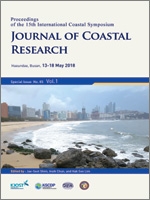Nguyen, Q.C.; Ian, D.G.; Mortlock R.T., and Gallop L.S., 2018. The influence of wind on hydrodynamic processes in Robbins Passage, Tasmania, Australia. In: Shim, J.-S.; Chun, I., and Lim, H.S. (eds.), Proceedings from the International Coastal Symposium (ICS) 2018 (Busan, Republic of Korea). Journal of Coastal Research, Special Issue No. 85, pp. 141–145. Coconut Creek (Florida), ISSN 0749-0208.
Understanding the hydrodynamic conditions in tidal inlets is vital for sustainable coastal management and structural design such as of harbours, sluices and dykes. The development and evolution of tidal inlets is due mainly to the interaction between tidal currents, longshore currents, waves and river flow with sediment transport. In addition, wind also plays an important role by generating local wind-waves that control the near-surface and also by its influence on water circulation. Robbins Passage is located off the far northwest of Tasmania, Australia. Robbins Passage is sheltered from swell, wave actions and uniquely oriented east-west, thus making it open to opposing wind directions and synoptic climate patterns. This study investigates the effect of wind on the hydrodynamic processes operating in Robbins Passage tidal inlet, using a two-dimensional flow model (MIKE21 HD) with high-resolution LiDAR-derived bathymetry. The simulated water levels were compared to water level observations at the eastern and western entrances of the inlet. Results from the calibrated model indicated that the model reproduces hydrodynamic conditions reasonably well (R2 = 0.89, RMSE = 0.09 at Kangaroo and R2 = 0.84, RMSE = 0.12 at Howie station). Results suggested that water level variations depend largely on wind direction. A shift in the predominant wind direction from Easterly to Westerly can change the tidal inlet regime from flood-dominated to ebb-dominated. Model results also indicate that a westerly wind stress can accelerate the ebb current and decrease water levels inside the inlet by up to 20% compared to easterly wind forcing, independent of tide. This may have implications for the hydrodynamic response of tidal inlets to changes in regional wind patterns predicted for the Southern Hemisphere mid-latitude tidal inlets.





